SEO
5 Amazing Landing Page Examples To Inspire Your Own

Landing pages – they’re powerful, aren’t they?
When we click on an ad, it’s the landing page that helps us decide what to do next.
Ideally, it makes you do a double-take and proclaim, “I must have this!”
It can also fall flat and go viral for all the wrong reasons. (I’m looking at you Rainbow capitalism.)
The design of a good landing page is an intersection of art, marketing, and psychology.
And, if you’re reading this article, that means you’re looking for guidance and inspiration to improve your own landing pages.
That’s exactly what we’re going to do.
We are going to share the features of what makes an amazing landing page and break down five examples to learn from.
Features Of An Amazing Landing Page
The hard truth: Getting people to opt in is tricky.
Even when the tech is amazing and the product is innovative.
If you send visitors to a webpage that fails to communicate the value, all of your market research and product development efforts go right down the drain.
The good news is this article is all about helping you create amazing landing pages that encourage more conversions – and, ultimately, generate more customers.
Improve your success rate by weaving these six features into your landing page design.
Poppin’
Landing pages should be distraction-free in order to focus on the task at hand – getting the visitor to convert.
This means that top navigation can be ditched in favor of a sleek, one-page design. Just be sure to leave a clickable logo in case users want a way out but still want to interact with your brand.
Revealing the product with clear annotated product visuals, helps visitors picture themselves using it.
Most importantly, the page has to pop! An eye-catching hero image and visuals help to capture the visitor’s attention and convey what the offer is in a way our brains can process quicker.
Free Of Fluff
The copy on a landing page is one of the most important elements. It’s what convinces website visitors to convert.
Great landing page copy uses strong headlines, clear value propositions, and explains “why” they matter.
Content should focus on user benefits over product features and address any doubts so visitors don’t leave.
The copy should be focused and free of fluff; every word should serve a purpose.
FOMO
FOMO is real. One of the most powerful persuasion techniques that landing pages can use is social proof.
If we see that others (we respect) are doing it, we are more likely to do it, too. This is the business equivalent of your mom asking you, “If everyone else jumped off a bridge, would you?”
…Yes, yes I would.
You can create FOMO by featuring testimonials from happy (relatable) customers or including statistics about how many people are using and loving the service or product.
Ready, Set, Go
A landing page shouldn’t feel like trying to break out of an escape room.
You need a strong call-to-action (CTA) if you want the visitor to convert.
A strong CTA is clear, concise, and explains why it’s important for the visitor to take this action.
A clear and concise call-to-action is just one action and the button contrasts with the page – this is so users can’t miss it.
Need For Speed
Page speed is how quickly a webpage loads. Basically, make sure it loads fast so people don’t leave. That’s it.
5 Examples Of Landing Pages
An amazing landing page is one that helps website visitors feel that this is the right company (or the right product) for the job.
And, there’s no better way to learn about what makes an amazing landing page than by exploring real-world examples from some of the best landing pages on the web.
Here are five examples of amazing landing pages.
1. ASOS
British online retailer ASOS is among the world’s most valuable apparel brands, competing with Nike, Adidas, and Zara.
This means there must be something really special behind those marketing strategies that online retailers can learn from.
Let’s see what they’re doing right.
I searched for [wedding guest plus size dresses] and saw a search network ad from ASOS which took me to a landing page for women’s plus size dresses for U.S. web visitors.
For starters, the ad took me directly to a landing page related to my search query – I love when that happens.
The full-length thumbnails of plus size models, moving in the dresses, helps me immediately know that I’m in the right place and I can begin to imagine myself in the product.
Top navigation breadcrumbs let me know exactly where I am on the site, so if I want to go back and see all the curve clothing, that’s really simple to do.
Filters are front and center for me to further refine my search by how new it is, eco-responsibility, color, price, and more.
Sales copy is free of fluff allowing the user to focus on the product (clothes). Description of the category page does include reference to which brands to check out for trending styles.
All in all, it’s a clean, well-organized landing page that keeps attention directly on the product.
ASOS may want to test adding social proof to their landing page by adding a filter based on user reviews or engage FOMO by highlighting that an item is selling fast.
2. DRIFT
B2B commerce startup Drift is a conversational marketing and sales technology company, well known for its live chatbot.
It is one of the only Latino-founded companies to ever achieve a valuation over $1 billion.
“Our purpose as a company remains simple and consistent: Build a platform that makes it simpler for customers to buy from you,” Drift CEO David Cancel said in a statement.
Let’s see how simple Drift makes their product to buy and check out their live-chat landing page.
 Screenshot from DRIFT, June 2022.
Screenshot from DRIFT, June 2022.Ok, I am geeking out over the bright and minimalistic design (slight 90s vibes); it looks so sharp on all devices.
Above the fold, we see a big, bold headline immediately addressing how the app helps business owners “engage and convert” with Drift’s solution “live chat.”
Below the headline, the content block explains why users are not engaging or converting: “Today’s buyer doesn’t want to wait.”
Nice contrasting color on the CTA inviting web visitors to “Get a Demo.”
The header image uses the product as the example which is 10x better than a stock photo.
And, I have to call out the shield icon in the bottom left-hand corner that opens privacy settings. This small addition provides site visitors with a subconscious affirmation that the company takes data privacy seriously.
As we scroll down the page, we see social proof with a video review by the senior director of a global marketing operations and technology company.
 Screenshot from DRIFT, June 2022.
Screenshot from DRIFT, June 2022.If you can get video reviews, do it! They are way more engaging than a standard text review because they’re really hard to fake.
Continuing to scroll down the page, the content teeter-totters between sharing different use cases with a summary and image or .gif and social proof in the form of a text quote or case study.
At the end of the long-form landing page, there is a solid call to action “start conversations with your website visitors now.” With a contrasting button, “Get a Demo.”
 Screenshot from DRIFT, June 2022.
Screenshot from DRIFT, June 2022.When you click on “Get a Demo” it launches the product itself and you interact with the Drift bot to book a demo.
Drift’s live chat page checks off all the features of an amazing landing page, making it extremely easy to buy from them.
3. LawnDoctor.com
Lawn Doctor offers lawn maintenance and pest control services, but it’s not your run-of-the-mill landscaping company.
This lawn care brand has grown to more than 630 locations, increasing its year-over-year sales by 16% in 2020.
Local service providers can learn a lot from Lawn Doctor’s landing page. Let’s take a look at how they’ve designed their landing page to attract new customers.
 Screenshot from Lawn Doctor, June 2022.
Screenshot from Lawn Doctor, June 2022.Lawn Doctor is such a great example for local service companies.
The color palette uses the rich color of green consumers wants to attain with a hero image featuring what the site visitor wants, a beautifully landscaped backyard.
Social proof is visualized with the 4.7 star average Google rating overlay on the image. The exact number of 4.7 is helpful because it feels like a real number and not an approximation.
The estimate form is available at the top; users don’t have to go scrolling for it, and a phone number is available in the top right corner for those that don’t want to wait.
When I enter my zip code into the form, the city and state are automatically populated for me which is awesome because I get lazy and don’t want to enter every detail.
Sales copy gets right to the point; the header explains you’re getting customized lawn care with a scientific approach.
The word choice “custom” and “scientific” makes me think that I’m getting a better service than I would from anyone else.
Below the header image but above the fold, Lawn Doctor upsells me services that are highly relevant to the current season.
I can click on that CTA to learn more or I’m more likely to ask about it when a sales representative calls me.
Just in case a user had any hesitation, there is a 100% refund if I’m not fully satisfied, followed by Google reviews for social proof.
The only thing this page is missing is the fear of missing out which Lawn Doctor could do with a countdown discount timer.
4. Flywheel
Flywheel was acquired by WP Engine in 2019.
The financial terms of the deal were not disclosed but in an interview, Heather Brunner confirmed Flywheel’s annual recurring revenue was $18 million at the time of acquisition.
What made Flywheel so successful? Aside from being a great managed WordPress hosting platform, the company’s marketing was dialed in. Take a look!
 Screenshot from Flywheel, June 2022.
Screenshot from Flywheel, June 2022.Top navigation is not present, helping the page visitor to stay focused on the content you want them to.
The logo reminds site visitors where they are and is clickable providing an easy escape back to the main domain.
The beautiful color scheme with the calm business blue and contrasting money green call-to-action button above the fold.
The headline includes the word “free” letting visitors know they won’t have to pay for the download.
Text is broken up into chunks making it easy to read on mobile.
 Screenshot from Flywheel, June 2022.
Screenshot from Flywheel, June 2022.Below the fold is a mini-preview of the chapters so I know what I’m exchanging my personal information for. Gives me a sense of whether or not it’s worth it to me.
The final CTA at the bottom of the landing page reinforces that the ebook is completely free and filled with secrets! The download is a quick and simple company email.
 Screenshot from Flywheel, June 2022.
Screenshot from Flywheel, June 2022.Form completion confirmation takes me to the product home page to further explore the product. All in all a beautiful ebook landing page that lead gen companies can learn from.
The only suggestion here is to add social proof near the bottom CTA to “seal the deal.”
5. Breathwrk
Breathwrk is a female-founded startup that raised an undisclosed amount from a total of 10 investors including Demo Lovato and BAM Ventures.
The breathing exercises app has over 1.2 million users worldwide.
Let’s see if the landing page can reduce our stress and improve landing page design?
The search query for this landing page was, “how to handle stress at work.”
 Screenshot from Breathwrk, June 2022.
Screenshot from Breathwrk, June 2022.The main Navigation is simplified, which keeps the users focused on the information you want them to look at.
But if they click the “More” button a drop-down list of additional pages (Science, FAQ, Blog, and more) is available.
The color palette is calming tones of blue and green with a contrasting CTA button “contact us” in purple.
Just like Drift, Breathwrk shows the product which allows site visitors to see what they’re going to get.
The headline starts with the main idea, “Improve your workplace,” and the subheading tells us how to “help your employees reduce stress and improve focus…”
Followed by the FOMO by showcasing the companies who are using the Breathwrk app for their employees.
As we scroll down the landing page, Breathwrk does a brilliant job explaining the app’s features from the perspective of the user.
 Screenshot from Breathwrk, June 2022.
Screenshot from Breathwrk, June 2022.A user doesn’t really care that there’s an option for breathing exercises before meetings but a user is interested in reducing employee stress and improving focus between back-to-back meetings, and before a big pitch.
The sales copy minimizes objections by explaining that the app is easy to set up and easy to manage.
 Screenshot from Breathwrk, June 2022.
Screenshot from Breathwrk, June 2022.This is important because the last thing an organization needs is stress setting up an app to reduce stress.
Easy onboarding, ongoing support, and user analytics (so you can see if employees are using the app and how they’re using the app).
Breathwrk provides social proof in the form of text review quotes right before the CTA “Get Breathwrk for your team” and form fill.
 Screenshot from Breathwrk, June 2022.
Screenshot from Breathwrk, June 2022.An amazing example of an App landing page. It grabs attention, shows the product, and explains how it creates value for the site visitor.
Final Thoughts
Overall, an amazing landing page helps site visitors decide what to do next.
Some features to consider when designing a landing page is:
- The design captures visitors’ attention and keeps it on the end goal.
- Copy is focused and free of fluff.
- Use social proof and FOMO.
- Minimize objections and have a clear CTA.
- Make sure it loads fast.
And, don’t forget to set up Analytics to measure and learn from user activity. Testing is going to be your secret to success.
More Resources:
Featured Image: Mila Supinskaya Glashchenko/Shutterstock
SEO
How To Write ChatGPT Prompts To Get The Best Results

ChatGPT is a game changer in the field of SEO. This powerful language model can generate human-like content, making it an invaluable tool for SEO professionals.
However, the prompts you provide largely determine the quality of the output.
To unlock the full potential of ChatGPT and create content that resonates with your audience and search engines, writing effective prompts is crucial.
In this comprehensive guide, we’ll explore the art of writing prompts for ChatGPT, covering everything from basic techniques to advanced strategies for layering prompts and generating high-quality, SEO-friendly content.
Writing Prompts For ChatGPT
What Is A ChatGPT Prompt?
A ChatGPT prompt is an instruction or discussion topic a user provides for the ChatGPT AI model to respond to.
The prompt can be a question, statement, or any other stimulus to spark creativity, reflection, or engagement.
Users can use the prompt to generate ideas, share their thoughts, or start a conversation.
ChatGPT prompts are designed to be open-ended and can be customized based on the user’s preferences and interests.
How To Write Prompts For ChatGPT
Start by giving ChatGPT a writing prompt, such as, “Write a short story about a person who discovers they have a superpower.”
ChatGPT will then generate a response based on your prompt. Depending on the prompt’s complexity and the level of detail you requested, the answer may be a few sentences or several paragraphs long.
Use the ChatGPT-generated response as a starting point for your writing. You can take the ideas and concepts presented in the answer and expand upon them, adding your own unique spin to the story.
If you want to generate additional ideas, try asking ChatGPT follow-up questions related to your original prompt.
For example, you could ask, “What challenges might the person face in exploring their newfound superpower?” Or, “How might the person’s relationships with others be affected by their superpower?”
Remember that ChatGPT’s answers are generated by artificial intelligence and may not always be perfect or exactly what you want.
However, they can still be a great source of inspiration and help you start writing.
Must-Have GPTs Assistant
I recommend installing the WebBrowser Assistant created by the OpenAI Team. This tool allows you to add relevant Bing results to your ChatGPT prompts.
This assistant adds the first web results to your ChatGPT prompts for more accurate and up-to-date conversations.
It is very easy to install in only two clicks. (Click on Start Chat.)
For example, if I ask, “Who is Vincent Terrasi?,” ChatGPT has no answer.
With WebBrower Assistant, the assistant creates a new prompt with the first Bing results, and now ChatGPT knows who Vincent Terrasi is.
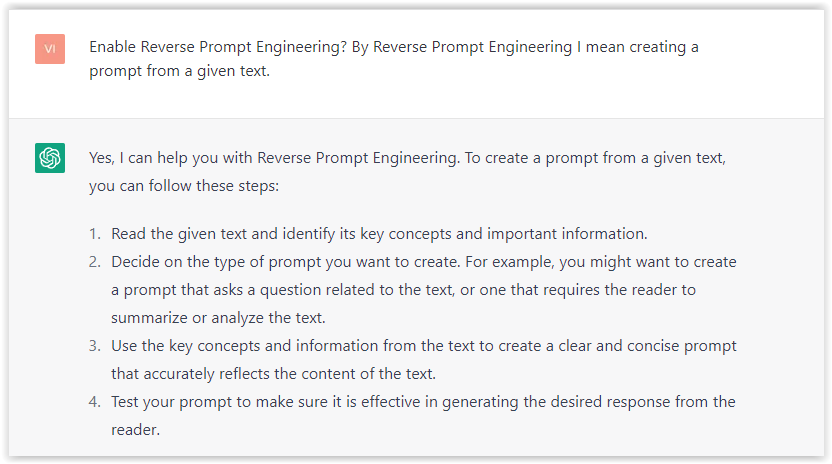 Screenshot from ChatGPT, March 2023
Screenshot from ChatGPT, March 2023You can test other GPT assistants available in the GPTs search engine if you want to use Google results.
Master Reverse Prompt Engineering
ChatGPT can be an excellent tool for reverse engineering prompts because it generates natural and engaging responses to any given input.
By analyzing the prompts generated by ChatGPT, it is possible to gain insight into the model’s underlying thought processes and decision-making strategies.
One key benefit of using ChatGPT to reverse engineer prompts is that the model is highly transparent in its decision-making.
This means that the reasoning and logic behind each response can be traced, making it easier to understand how the model arrives at its conclusions.
Once you’ve done this a few times for different types of content, you’ll gain insight into crafting more effective prompts.
Prepare Your ChatGPT For Generating Prompts
First, activate the reverse prompt engineering.
- Type the following prompt: “Enable Reverse Prompt Engineering? By Reverse Prompt Engineering I mean creating a prompt from a given text.”
 Screenshot from ChatGPT, March 2023
Screenshot from ChatGPT, March 2023ChatGPT is now ready to generate your prompt. You can test the product description in a new chatbot session and evaluate the generated prompt.
- Type: “Create a very technical reverse prompt engineering template for a product description about iPhone 11.”
 Screenshot from ChatGPT, March 2023
Screenshot from ChatGPT, March 2023The result is amazing. You can test with a full text that you want to reproduce. Here is an example of a prompt for selling a Kindle on Amazon.
- Type: “Reverse Prompt engineer the following {product), capture the writing style and the length of the text :
product =”
 Screenshot from ChatGPT, March 2023
Screenshot from ChatGPT, March 2023I tested it on an SEJ blog post. Enjoy the analysis – it is excellent.
- Type: “Reverse Prompt engineer the following {text}, capture the tone and writing style of the {text} to include in the prompt :
text = all text coming from https://www.searchenginejournal.com/google-bard-training-data/478941/”
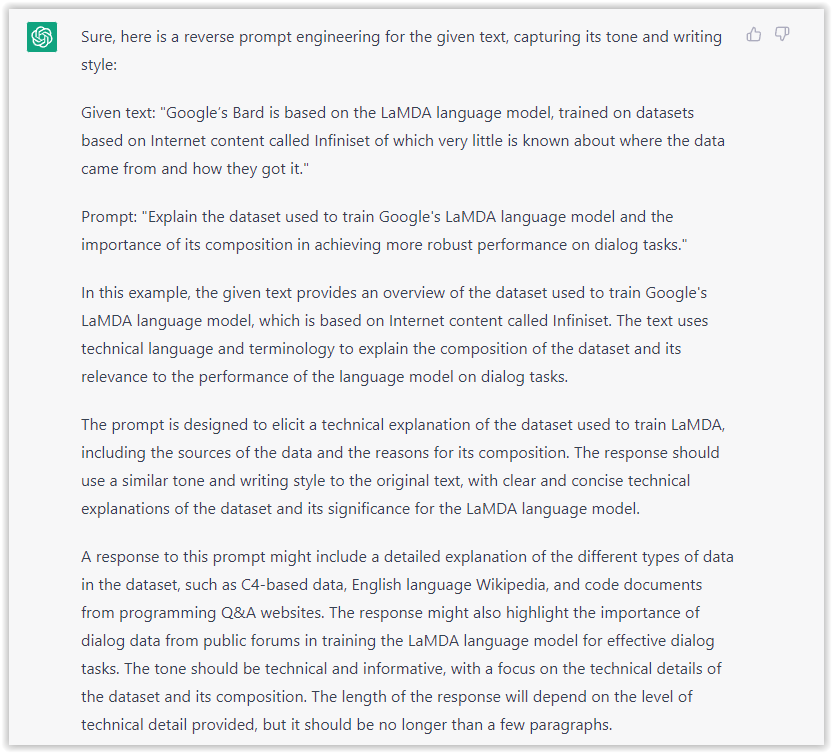 Screenshot from ChatGPT, March 2023
Screenshot from ChatGPT, March 2023But be careful not to use ChatGPT to generate your texts. It is just a personal assistant.
Go Deeper
Prompts and examples for SEO:
- Keyword research and content ideas prompt: “Provide a list of 20 long-tail keyword ideas related to ‘local SEO strategies’ along with brief content topic descriptions for each keyword.”
- Optimizing content for featured snippets prompt: “Write a 40-50 word paragraph optimized for the query ‘what is the featured snippet in Google search’ that could potentially earn the featured snippet.”
- Creating meta descriptions prompt: “Draft a compelling meta description for the following blog post title: ’10 Technical SEO Factors You Can’t Ignore in 2024′.”
Important Considerations:
- Always Fact-Check: While ChatGPT can be a helpful tool, it’s crucial to remember that it may generate inaccurate or fabricated information. Always verify any facts, statistics, or quotes generated by ChatGPT before incorporating them into your content.
- Maintain Control and Creativity: Use ChatGPT as a tool to assist your writing, not replace it. Don’t rely on it to do your thinking or create content from scratch. Your unique perspective and creativity are essential for producing high-quality, engaging content.
- Iteration is Key: Refine and revise the outputs generated by ChatGPT to ensure they align with your voice, style, and intended message.
Additional Prompts for Rewording and SEO:
– Rewrite this sentence to be more concise and impactful.
– Suggest alternative phrasing for this section to improve clarity.
– Identify opportunities to incorporate relevant internal and external links.
– Analyze the keyword density and suggest improvements for better SEO.
Remember, while ChatGPT can be a valuable tool, it’s essential to use it responsibly and maintain control over your content creation process.
Experiment And Refine Your Prompting Techniques
Writing effective prompts for ChatGPT is an essential skill for any SEO professional who wants to harness the power of AI-generated content.
Hopefully, the insights and examples shared in this article can inspire you and help guide you to crafting stronger prompts that yield high-quality content.
Remember to experiment with layering prompts, iterating on the output, and continually refining your prompting techniques.
This will help you stay ahead of the curve in the ever-changing world of SEO.
More resources:
Featured Image: Tapati Rinchumrus/Shutterstock
SEO
Measuring Content Impact Across The Customer Journey
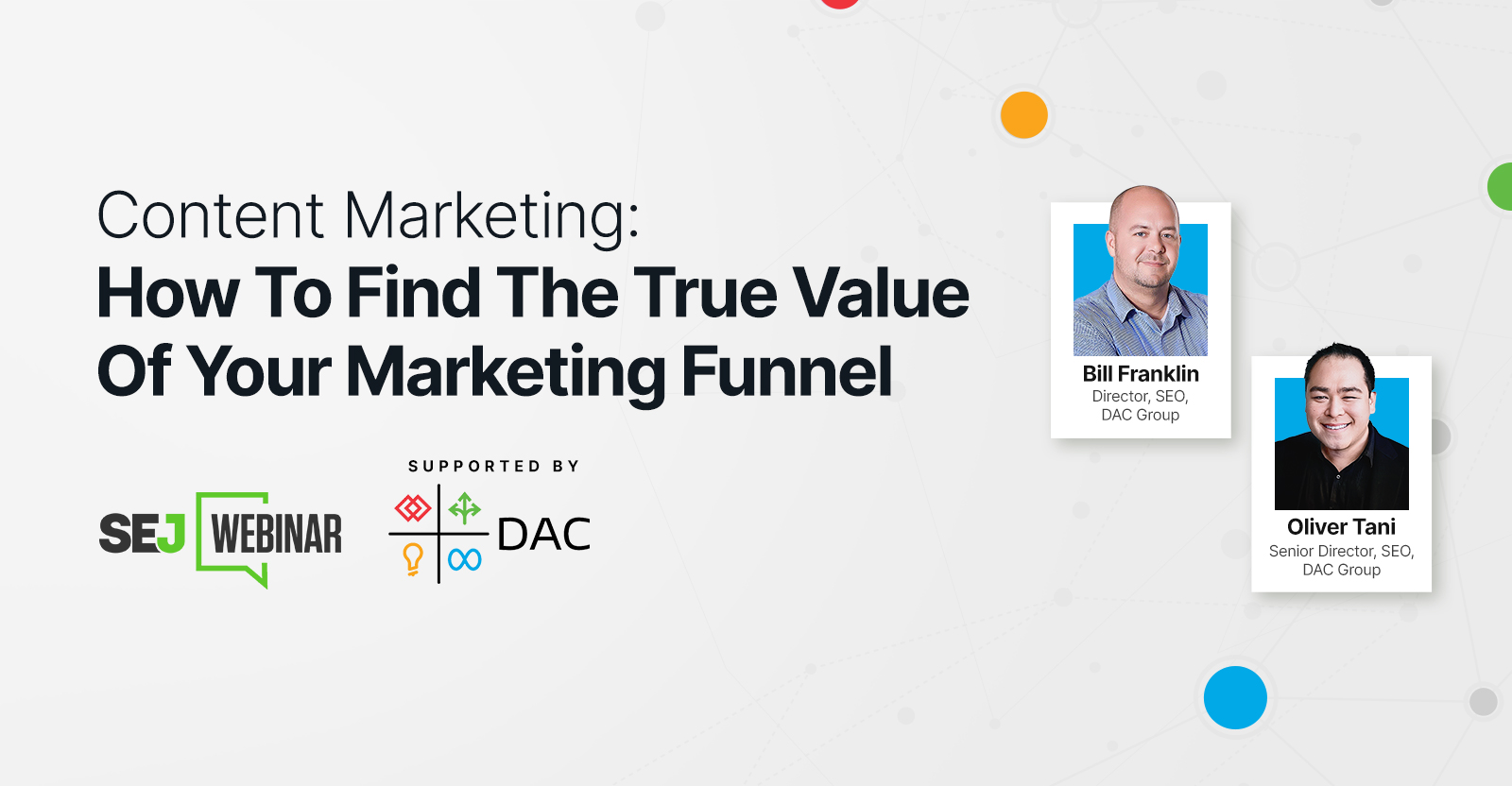
Understanding the impact of your content at every touchpoint of the customer journey is essential – but that’s easier said than done. From attracting potential leads to nurturing them into loyal customers, there are many touchpoints to look into.
So how do you identify and take advantage of these opportunities for growth?
Watch this on-demand webinar and learn a comprehensive approach for measuring the value of your content initiatives, so you can optimize resource allocation for maximum impact.
You’ll learn:
- Fresh methods for measuring your content’s impact.
- Fascinating insights using first-touch attribution, and how it differs from the usual last-touch perspective.
- Ways to persuade decision-makers to invest in more content by showcasing its value convincingly.
With Bill Franklin and Oliver Tani of DAC Group, we unravel the nuances of attribution modeling, emphasizing the significance of layering first-touch and last-touch attribution within your measurement strategy.
Check out these insights to help you craft compelling content tailored to each stage, using an approach rooted in first-hand experience to ensure your content resonates.
Whether you’re a seasoned marketer or new to content measurement, this webinar promises valuable insights and actionable tactics to elevate your SEO game and optimize your content initiatives for success.
View the slides below or check out the full webinar for all the details.
SEO
How to Find and Use Competitor Keywords

Competitor keywords are the keywords your rivals rank for in Google’s search results. They may rank organically or pay for Google Ads to rank in the paid results.
Knowing your competitors’ keywords is the easiest form of keyword research. If your competitors rank for or target particular keywords, it might be worth it for you to target them, too.
There is no way to see your competitors’ keywords without a tool like Ahrefs, which has a database of keywords and the sites that rank for them. As far as we know, Ahrefs has the biggest database of these keywords.
How to find all the keywords your competitor ranks for
- Go to Ahrefs’ Site Explorer
- Enter your competitor’s domain
- Go to the Organic keywords report
The report is sorted by traffic to show you the keywords sending your competitor the most visits. For example, Mailchimp gets most of its organic traffic from the keyword “mailchimp.”


Since you’re unlikely to rank for your competitor’s brand, you might want to exclude branded keywords from the report. You can do this by adding a Keyword > Doesn’t contain filter. In this example, we’ll filter out keywords containing “mailchimp” or any potential misspellings:
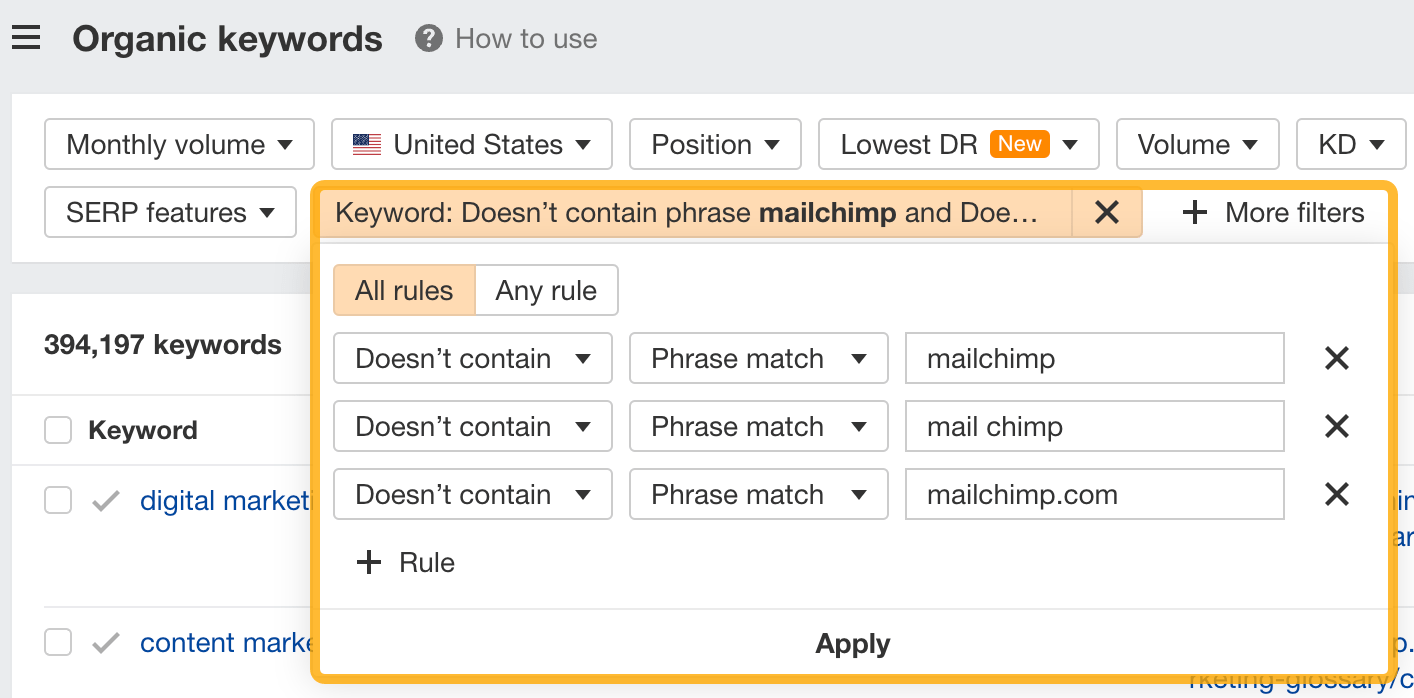

If you’re a new brand competing with one that’s established, you might also want to look for popular low-difficulty keywords. You can do this by setting the Volume filter to a minimum of 500 and the KD filter to a maximum of 10.


How to find keywords your competitor ranks for, but you don’t
- Go to Competitive Analysis
- Enter your domain in the This target doesn’t rank for section
- Enter your competitor’s domain in the But these competitors do section


Hit “Show keyword opportunities,” and you’ll see all the keywords your competitor ranks for, but you don’t.


You can also add a Volume and KD filter to find popular, low-difficulty keywords in this report.


How to find keywords multiple competitors rank for, but you don’t
- Go to Competitive Analysis
- Enter your domain in the This target doesn’t rank for section
- Enter the domains of multiple competitors in the But these competitors do section
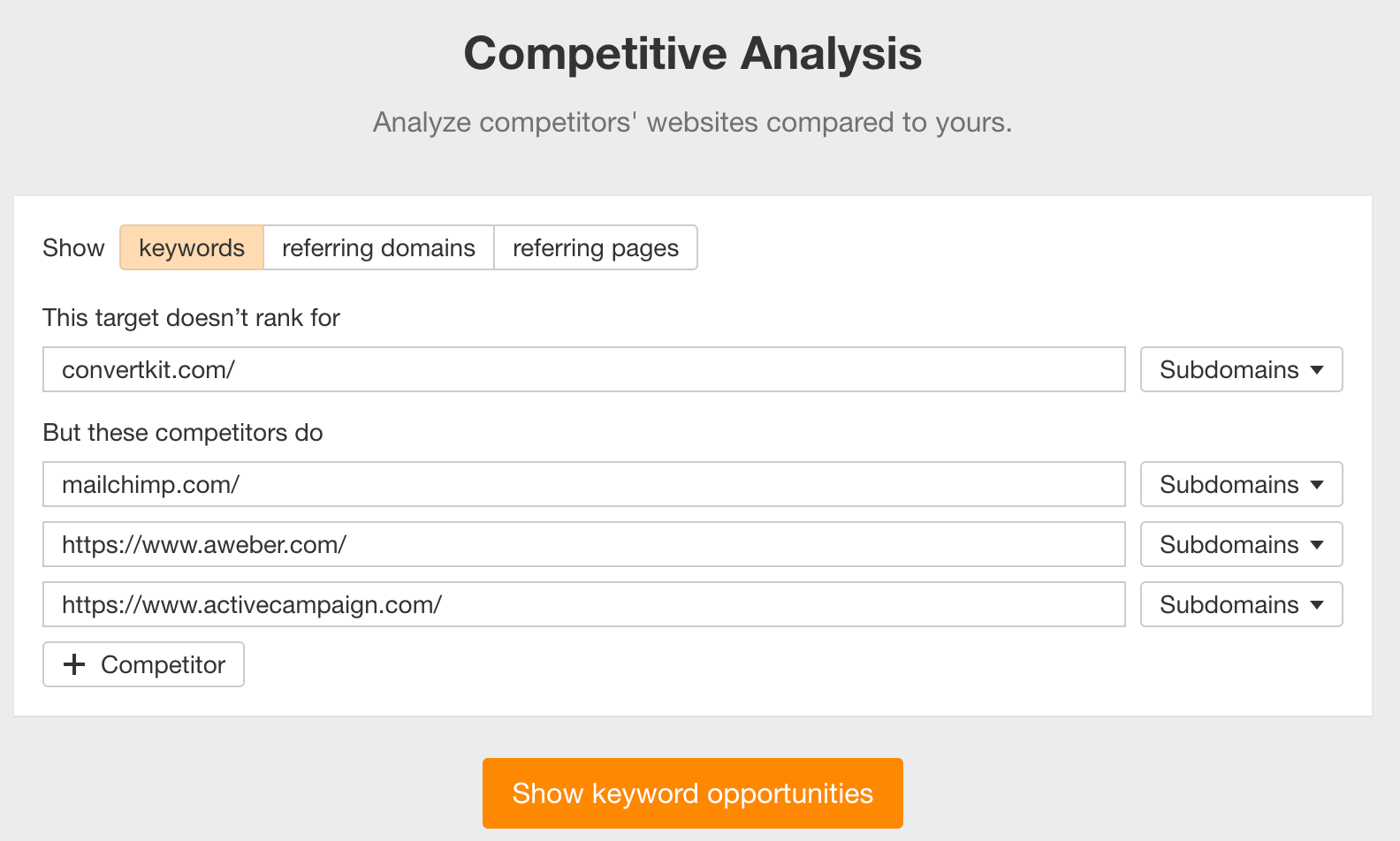

You’ll see all the keywords that at least one of these competitors ranks for, but you don’t.


You can also narrow the list down to keywords that all competitors rank for. Click on the Competitors’ positions filter and choose All 3 competitors:


- Go to Ahrefs’ Site Explorer
- Enter your competitor’s domain
- Go to the Paid keywords report
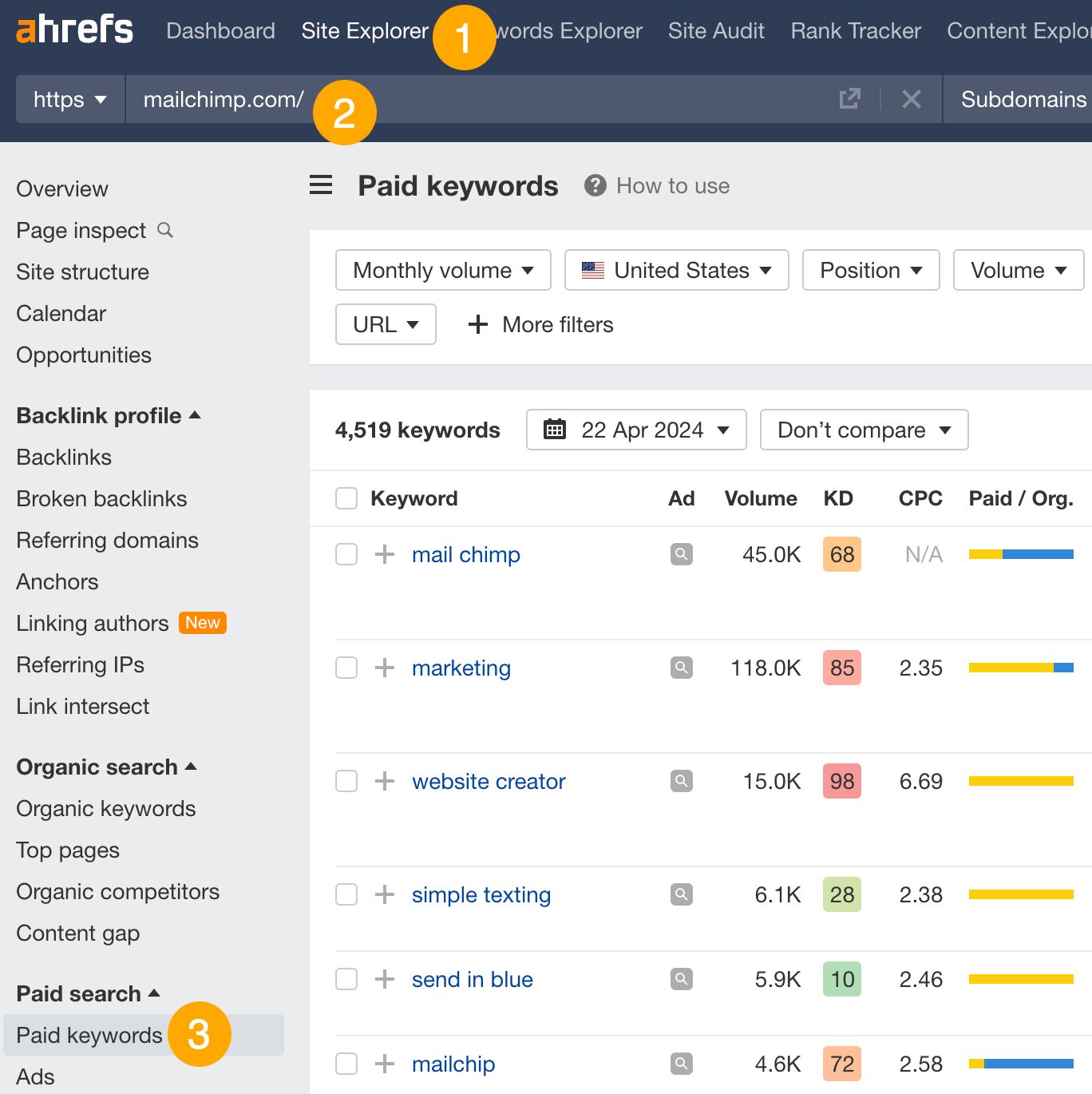

This report shows you the keywords your competitors are targeting via Google Ads.
Since your competitor is paying for traffic from these keywords, it may indicate that they’re profitable for them—and could be for you, too.
You know what keywords your competitors are ranking for or bidding on. But what do you do with them? There are basically three options.
1. Create pages to target these keywords
You can only rank for keywords if you have content about them. So, the most straightforward thing you can do for competitors’ keywords you want to rank for is to create pages to target them.
However, before you do this, it’s worth clustering your competitor’s keywords by Parent Topic. This will group keywords that mean the same or similar things so you can target them all with one page.
Here’s how to do that:
- Export your competitor’s keywords, either from the Organic Keywords or Content Gap report
- Paste them into Keywords Explorer
- Click the “Clusters by Parent Topic” tab


For example, MailChimp ranks for keywords like “what is digital marketing” and “digital marketing definition.” These and many others get clustered under the Parent Topic of “digital marketing” because people searching for them are all looking for the same thing: a definition of digital marketing. You only need to create one page to potentially rank for all these keywords.
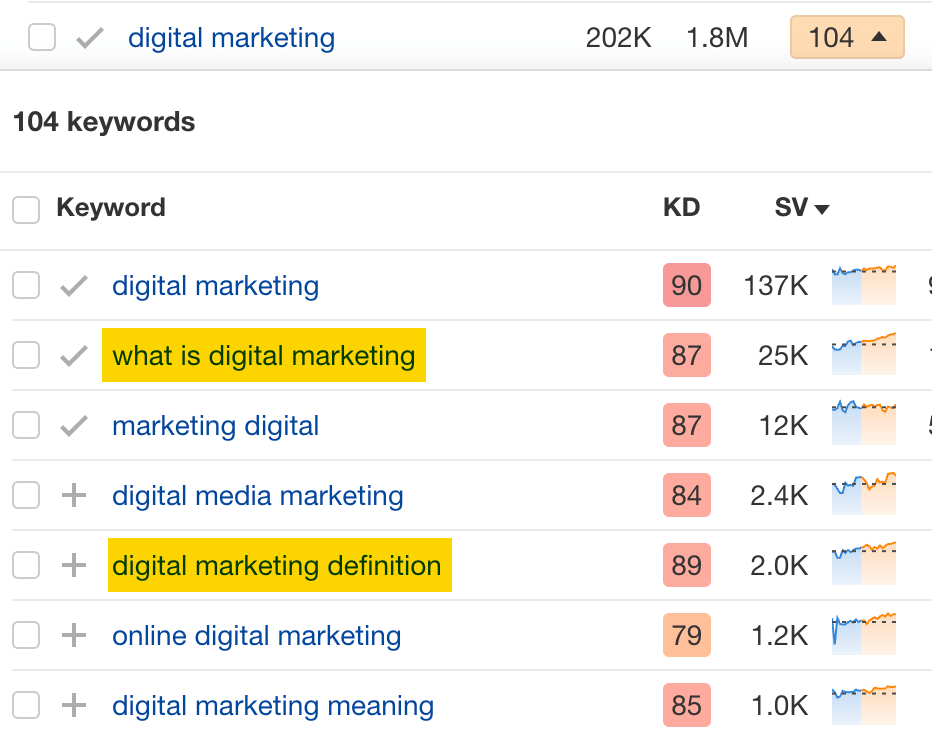

2. Optimize existing content by filling subtopics
You don’t always need to create new content to rank for competitors’ keywords. Sometimes, you can optimize the content you already have to rank for them.
How do you know which keywords you can do this for? Try this:
- Export your competitor’s keywords
- Paste them into Keywords Explorer
- Click the “Clusters by Parent Topic” tab
- Look for Parent Topics you already have content about
For example, if we analyze our competitor, we can see that seven keywords they rank for fall under the Parent Topic of “press release template.”


If we search our site, we see that we already have a page about this topic.


If we click the caret and check the keywords in the cluster, we see keywords like “press release example” and “press release format.”
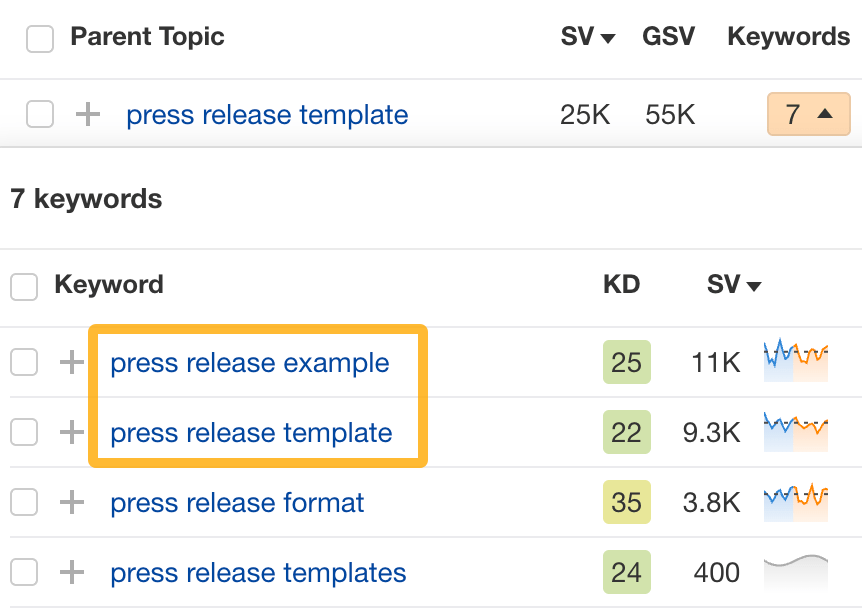

To rank for the keywords in the cluster, we can probably optimize the page we already have by adding sections about the subtopics of “press release examples” and “press release format.”
3. Target these keywords with Google Ads
Paid keywords are the simplest—look through the report and see if there are any relevant keywords you might want to target, too.
For example, Mailchimp is bidding for the keyword “how to create a newsletter.”


If you’re ConvertKit, you may also want to target this keyword since it’s relevant.
If you decide to target the same keyword via Google Ads, you can hover over the magnifying glass to see the ads your competitor is using.
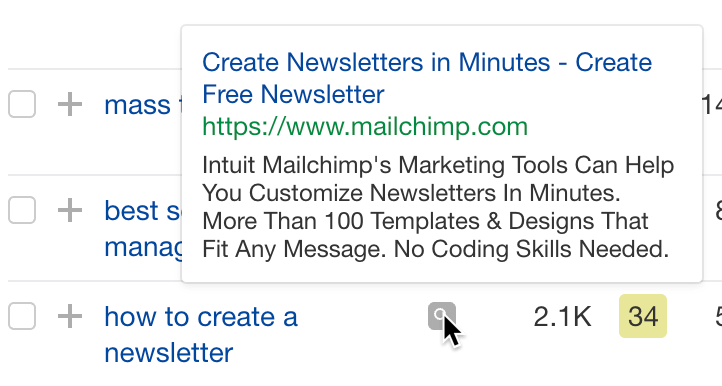

You can also see the landing page your competitor directs ad traffic to under the URL column.


Learn more
Check out more tutorials on how to do competitor keyword analysis:
-

 PPC5 days ago
PPC5 days ago19 Best SEO Tools in 2024 (For Every Use Case)
-

 MARKETING7 days ago
MARKETING7 days agoStreamlining Processes for Increased Efficiency and Results
-
SEARCHENGINES7 days ago
Daily Search Forum Recap: April 17, 2024
-

 PPC7 days ago
PPC7 days ago97 Marvelous May Content Ideas for Blog Posts, Videos, & More
-

 SEO7 days ago
SEO7 days agoAn In-Depth Guide And Best Practices For Mobile SEO
-
SEARCHENGINES6 days ago
Daily Search Forum Recap: April 18, 2024
-

 MARKETING6 days ago
MARKETING6 days agoEcommerce evolution: Blurring the lines between B2B and B2C
-
SEARCHENGINES4 days ago
Daily Search Forum Recap: April 19, 2024
















You must be logged in to post a comment Login